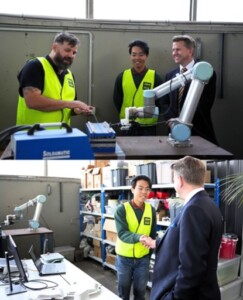POSTED: 25 Aug, 2025
PhD Research Spotlight: Zongyuan Zhang Tackles Contact Tasks with Mobile Robots
As part of the Biomimic Cobots program within the Australian Cobotics Centre, PhD researcher Zongyuan Zhang is leading a project that addresses a key challenge in manufacturing: enabling mobile robots to perform high-precision contact tasks, such as grinding, polishing, and welding, on large, arbitrarily placed workpieces in factory environments.
Zongyuan brings a diverse background in robotics to this work. He holds an M.Sc. in Robotics from the University of Birmingham, UK, where he focused on applying deep learning to manipulator force control. His experience spans control system design, mechanical structure design, and participation in a range of innovative robotics projects—including underwater photography robots, driverless racing cars, exoskeleton mechanical arms, dual-rotor aircraft, and remote-control robotic arms—some of which are now undergoing commercialisation.
His PhD project, Contact Task Execution by Robot with Non-Rigid Fixation, investigates how robots with non-rigidly fixed chassis can maintain the accuracy, stability, and adaptability required for industrial contact tasks. These tasks typically demand hybrid force/position control and high contact forces, which are complicated by the mobility and flexibility of the robot’s base.
This research contributes to the Biomimic Cobots program’s goal of developing collaborative robots that mimic human sensing, learning, and manipulation skills. It explores:
- How a robot mimics human control to execute contact tasks like sanding and grinding.
- How augmented mobility enables task execution in large, unconstrained spaces.
- How minimal task-specific programming can be used to adapt to new workpieces and environments.
Zongyuan, based at QUT, is supervised by Professor Jonathan Roberts, Professor Will Browne, and Dr Chris Lehnert, and is working onsite at ARM Hub alongside industry partner, Vaulta. The project with industrial partners concerns the efficient and accurate removal of surface oxides from metallic materials, thereby enabling tighter bonding between metal components. This embedded collaboration ensures his research is conducted in real production environments and remains grounded in the practical needs of Australian manufacturers.
Recent milestones include the:
- Design and deployment a framework for performing industrial sanding tasks using collaborative robots.
- Utilisation of sound as a multimodal input to improve the robustness of the sanding process and enhance the cost-efficiency of the robotic system.
- Exploration of how humanoid robots can achieve high-precision performance in contact tasks.
Check out our website for the latest on his project: Project 1.1 – Contact task execution by robot with non-rigid fixation » Australian Cobotics Centre | ARC funded ITTC for Collaborative Robotics in Advanced Manufacturing

Recent News
Australian Cobotics Centre Annual Symposium 2025: A Celebration of Collaboration and Impact
Australian Cobotics Centre Annual Symposium 2025: A Celebration of Collaboration and Impact The Australian Cobotics Centre’s annual symposium b ...
2025 OzCHI Conference
Many of our team were in Sydney last week for OzCHI: Australian Conference on Computer-Human Interaction. Our Deputy Director, Prof Glenda Caldwell ...
Success at the QUT Vice Chancellors Awards for Excellence
We’re thrilled for Professor Jonathan Roberts, Director of the Australian Cobotics Centre and Professor in Robotics at QUT (Queensland University of ...